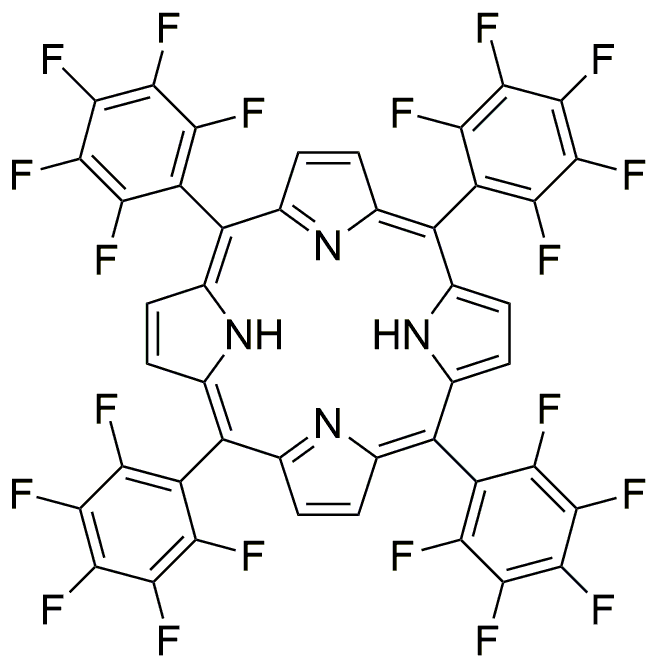5,10,15,20-Tetrakis(pentafluorophenyl)porphyrin is widely utilized in research focused on:
- Photodynamic Therapy: This compound is used in medical applications for cancer treatment, where it acts as a photosensitizer, generating reactive oxygen species upon light activation to target and destroy cancer cells.
- Organic Photovoltaics: It serves as a key material in the development of organic solar cells, enhancing light absorption and improving energy conversion efficiency, making solar energy more accessible and sustainable.
- Fluorescent Probes: In analytical chemistry, it is employed as a fluorescent probe for detecting metal ions and other analytes, providing sensitive and selective measurement techniques in various environmental and biological samples.
- Catalysis: The compound is utilized in catalysis, particularly in organic reactions, where it can facilitate electron transfer processes, improving reaction rates and yields compared to traditional catalysts.
- Materials Science: It is applied in the synthesis of advanced materials, including sensors and nanomaterials, due to its unique electronic properties, which can enhance the performance of electronic devices.
Informations générales
Propriétés
Sécurité et réglementation
Applications
5,10,15,20-Tetrakis(pentafluorophenyl)porphyrin is widely utilized in research focused on:
- Photodynamic Therapy: This compound is used in medical applications for cancer treatment, where it acts as a photosensitizer, generating reactive oxygen species upon light activation to target and destroy cancer cells.
- Organic Photovoltaics: It serves as a key material in the development of organic solar cells, enhancing light absorption and improving energy conversion efficiency, making solar energy more accessible and sustainable.
- Fluorescent Probes: In analytical chemistry, it is employed as a fluorescent probe for detecting metal ions and other analytes, providing sensitive and selective measurement techniques in various environmental and biological samples.
- Catalysis: The compound is utilized in catalysis, particularly in organic reactions, where it can facilitate electron transfer processes, improving reaction rates and yields compared to traditional catalysts.
- Materials Science: It is applied in the synthesis of advanced materials, including sensors and nanomaterials, due to its unique electronic properties, which can enhance the performance of electronic devices.
Documents
Fiches de données de sécurité (FDS)
La FDS fournit des informations de sécurité complètes sur la manipulation, le stockage et l’élimination du produit.
Spécifications du produit (PS)
Le PS fournit une description complète des propriétés du produit, notamment sa composition chimique, son état physique, sa pureté et les exigences de stockage. Il détaille également les plages de qualité acceptables et les applications prévues du produit.
Certificats d'analyse (COA)
Recherchez des certificats d'analyse (COA) en saisissant le numéro de lot du produit. Les numéros de lot et de lot se trouvent sur l'étiquette d'un produit, après les mots « Lot » ou « Lot de fabrication ».
Numéro de catalogue
Numéro de lot/série
Certificats d'origine (COO)
Ce certificat d'exploitation confirme le pays dans lequel le produit a été fabriqué, et détaille également les matériaux et composants utilisés et s'il est issu de sources naturelles, synthétiques ou autres sources spécifiques. Ce certificat peut être requis pour les douanes, le commerce et la conformité réglementaire.
Numéro de catalogue
Numéro de lot/série
Fiches de données de sécurité (FDS)
La FDS fournit des informations de sécurité complètes sur la manipulation, le stockage et l’élimination du produit.
DownloadSpécifications du produit (PS)
Le PS fournit une description complète des propriétés du produit, notamment sa composition chimique, son état physique, sa pureté et les exigences de stockage. Il détaille également les plages de qualité acceptables et les applications prévues du produit.
DownloadCertificats d'analyse (COA)
Recherchez des certificats d'analyse (COA) en saisissant le numéro de lot du produit. Les numéros de lot et de lot se trouvent sur l'étiquette d'un produit, après les mots « Lot » ou « Lot de fabrication ».
Numéro de catalogue
Numéro de lot/série
Certificats d'origine (COO)
Ce certificat d'exploitation confirme le pays dans lequel le produit a été fabriqué, et détaille également les matériaux et composants utilisés et s'il est issu de sources naturelles, synthétiques ou autres sources spécifiques. Ce certificat peut être requis pour les douanes, le commerce et la conformité réglementaire.


